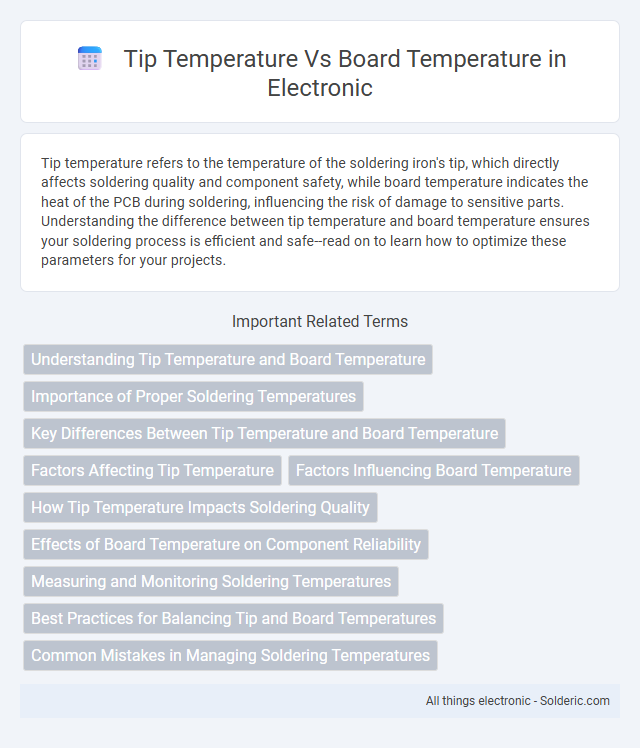Tip temperature refers to the temperature of the soldering iron's tip, which directly affects soldering quality and component safety, while board temperature indicates the heat of the PCB during soldering, influencing the risk of damage to sensitive parts. Understanding the difference between tip temperature and board temperature ensures your soldering process is efficient and safe--read on to learn how to optimize these parameters for your projects.
Comparison Table
| Parameter | Tip Temperature | Board Temperature |
|---|---|---|
| Definition | The temperature at the soldering iron tip during operation. | The temperature on the PCB surface or component being soldered. |
| Measurement Location | Directly at the soldering tip. | On the printed circuit board near the solder joint. |
| Typical Range | 200degC to 450degC (392degF to 842degF) | 50degC to 250degC (122degF to 482degF) |
| Purpose | Ensures proper heat transfer and solder melting. | Monitors thermal impact on board and components. |
| Impact on Quality | High tip temps can cause oxidation or damage. | Excessive board temps risk PCB delamination or component failure. |
| Control Method | Temperature-controlled soldering stations. | Thermal profiling and heat sinks. |
Understanding Tip Temperature and Board Temperature
Tip temperature refers to the heat level at the soldering iron's tip, which is critical for effective soldering without damaging components. Board temperature measures the heat on the printed circuit board surface, influencing solder joint quality and preventing thermal stress. Monitoring both temperatures ensures Your soldering process maintains optimal thermal conditions for reliable electronic assembly.
Importance of Proper Soldering Temperatures
Proper soldering temperatures, including the tip temperature and board temperature, are crucial to ensure reliable electrical connections and avoid damage. Maintaining the correct tip temperature prevents overheating components, while monitoring the board temperature ensures uniform heat distribution, preserving the integrity of sensitive substrates. You must optimize both temperatures to achieve strong solder joints and extend the lifespan of your electronic assemblies.
Key Differences Between Tip Temperature and Board Temperature
Tip temperature refers to the heat level at the soldering iron's tip, typically reaching between 200degC to 450degC, while board temperature is the temperature of the printed circuit board (PCB) during soldering, generally maintained between 60degC and 150degC. Tip temperature directly influences solder melting and joint quality, whereas board temperature affects the thermal stress and overall reliability of electronic components. Precise control of both temperatures is essential to prevent overheating, ensure proper solder flow, and avoid damage to sensitive PCB materials.
Factors Affecting Tip Temperature
Tip temperature is influenced by soldering iron power rating, thermal conductivity of the tip material, and the heat capacity of the tip itself, which determine how quickly the tip heats and cools during operation. Board temperature impacts heat dissipation rates, with thicker or more thermally conductive PCBs drawing heat away faster, requiring higher tip temperatures for effective solder joints. Contact time between the tip and the board also affects temperature stabilization, as longer contact allows for greater heat transfer, influencing the optimum tip temperature settings.
Factors Influencing Board Temperature
Board temperature is influenced by factors such as ambient temperature, component power dissipation, airflow, and thermal conductivity of the board materials. The tip temperature of a soldering iron affects your board temperature by transferring heat directly to the solder joint, where insufficient control can cause overheating and damage. Proper management of these factors ensures optimal thermal performance and protects sensitive components.
How Tip Temperature Impacts Soldering Quality
Tip temperature directly affects soldering quality by ensuring proper heat transfer to the joint, which prevents cold solder joints and minimizes thermal damage to components. Maintaining an optimal tip temperature range typically between 315degC and 370degC helps achieve strong, reliable connections without overheating the circuit board. Your ability to control and monitor this temperature ensures consistent solder flow and enhances overall electronic assembly durability.
Effects of Board Temperature on Component Reliability
Elevated board temperatures significantly reduce component reliability by accelerating thermal stress and promoting material degradation. Consistent exposure to high board temperatures leads to increased failure rates in solder joints and semiconductor devices, compromising circuit integrity. Maintaining optimal board temperature is critical to prolonging component lifespan and ensuring stable electronic device performance.
Measuring and Monitoring Soldering Temperatures
Accurate measurement of tip temperature and board temperature is crucial for effective soldering, ensuring reliable joints and preventing component damage. Use calibrated thermocouples or infrared sensors to monitor soldering iron tip temperature, while soldering stations with integrated temperature control enhance precision. Your ability to continuously track both temperatures helps maintain optimal thermal profiles, improving solder quality and board longevity.
Best Practices for Balancing Tip and Board Temperatures
Maintaining optimal balance between tip temperature and board temperature is essential for effective soldering, with tip temperatures typically ranging from 300degC to 350degC to ensure proper heat transfer without damaging components. Monitoring board temperature by using thermal imaging or thermocouples helps prevent overheating sensitive circuit elements, often keeping it below 150degC for most PCBs. Consistent tip maintenance, precise temperature control, and choosing appropriate heat profiles tailored to component specifications are best practices to maximize solder joint reliability and minimize board thermal stress.
Common Mistakes in Managing Soldering Temperatures
Mismanaging soldering temperatures often stems from confusing tip temperature with board temperature, leading to overheating or insufficient heat transfer. Setting the tip temperature too high can damage sensitive PCB components, while too low can cause weak solder joints and poor electrical connections. Proper calibration of the soldering iron and using a thermal probe to monitor board temperature ensures optimal heat distribution and reliable soldering results.
tip temperature vs board temperature Infographic

 solderic.com
solderic.com